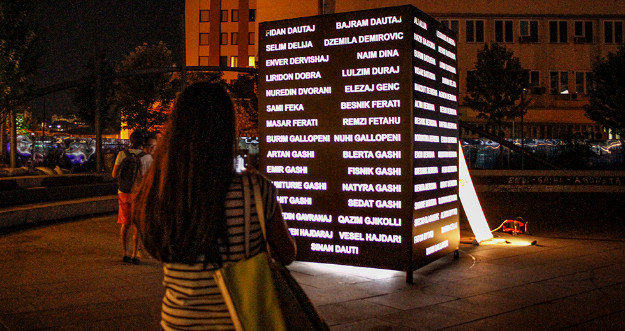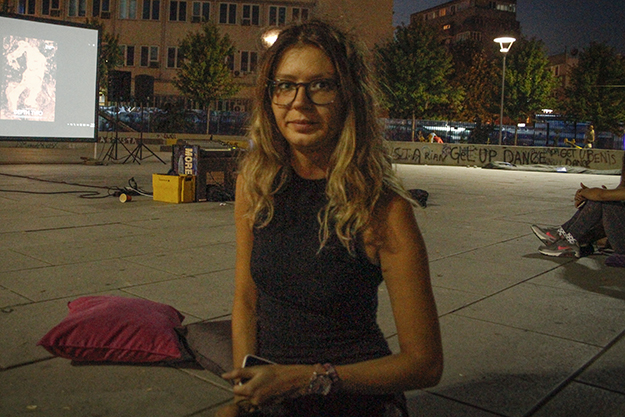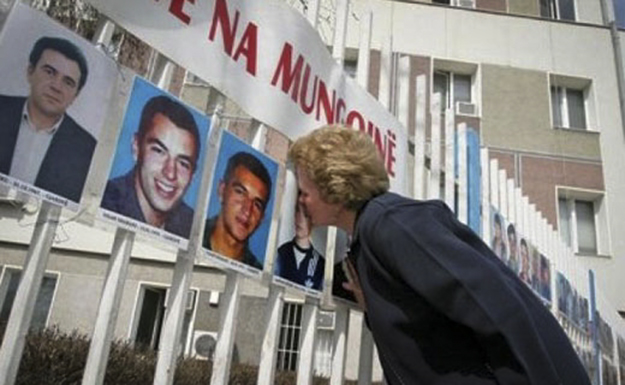On Tuesday (August 30), the International Day of the Victims of Enforced Disappearances, a powerful documentary recounting some of the atrocities committed by Slobodan Milosevic’s regime in Kosovo was shown in the center of Prishtina. Families of missing persons, human rights activists and other citizens gathered in the Zahir Pajaziti amphitheatre for a special screening of Serb director Ognjen Glavonic’s “Depth Two.”

An installation with the names of the 116 children still missing from the Kosovo war was unveiled in Prishtina on Tuesday evening. (Photo: Fikret Ahmeti / K2.0)
The documentary was screened as part of Youth Initiative for Human Rights (YIHR) activities as the organization sent a clear message to Kosovar authorities: The prolonged agony experienced by the families of the approximately 1,665 persons still missing from the war in Kosovo needs to end and that government inertia is taking the opportunity to mourn their loved ones away from victims’ families. After the documentary, ‘The Box of Mourning’ (‘Kutia e Zise’), a black box with the names of the 116 children who have never been located after being disappeared by force during the Kosovo war, was lit up as a poignant installation.
“Depth Two”
A truck filled with the bodies of children, old people, women and men is lifted from the Danube river; Shyhrete Berisha tells the horrifying events of the massacre of the Berisha family by Serbian forces; the bodies of Kosovar Albanians are taken from their initial graves to be transported and plunged into the river near Serbia’s border with Romania; perpetrators tell how Milosevic’s regime organized a detailed logistics operation to cover up the atrocities — in 2001 mass graves containing the remains of more than 700 war victims were uncovered on Serbian Ministry of Interior land at Batajnica, near Belgrade.
Using voiceover testimonies of victims and perpetrators from trials at the International Criminal Tribunal for the former Yugoslavia (ICTY), “Depth Two” reconstructs some of the horrific events that took place during the 1999 NATO bombing in Kosovo and Serbia. Without using footage from the time, voiceovers are visually paired with present-day images from the locations of the crimes — blurry river and lifeless streets, houses, trees and grass — that feed the tone and atmosphere and enable the audience to create their own imagery and judgement of the atrocities.
“We think that the topic addressed in this movie is something very important to be shown, not only in Kosovo, but everywhere, particularly in Serbia,” YIHR’s Acting Director Teuta Hoxha told K2.0. “Being in contact with young people we noticed that they don’t have a lot of information about what happened during the war, they don’t have information about what happened, not only against their own community, but against all communities in Kosovo … in particular they don’t know about the existence of the mass grave in Batajnica that was 20km from Belgrade.”

YIHR’s Acting Director Teuta Hoxha stresses the need for young people in particular to have more information about what happened during the war in Kosovo. (Photo: Fikret Ahmeti / K2.0)
On Monday, YIHR sent a small black box to the Kosovo Prime Minister’s Office. It contained a pair of children’s shoes, a letter and a list of the names of missing persons from the war. “While being persistent in realizing the rights of victims’ families in particular, and society in general, as activists through symbolic actions we continue to raise attention about the issue of missing persons relying on Article 5 of the Law on Missing Persons, which states that the families have the right to know about the fate of their missing family members,” reads the letter.
Hoxha explained that the aim of the action was also to express concern that Kosovar representatives have failed to raise the issue of missing persons as part of the EU-facilitated Serbia-Kosovo dialogue, despite promises made to victims’ families.

Around 1,665 people are still missing from the war in Kosovo.
Uncovering the evidence
At the end of the war, it was estimated that more than 5,000 people were missing. That number has decreased over the years, in part due to the steady uncovering of mass graves — bodies of hundreds of Kosovar Albanians were transferred to Serbia by Serbian forces and buried in mass graves as a way of hiding the evidence of atrocities.


